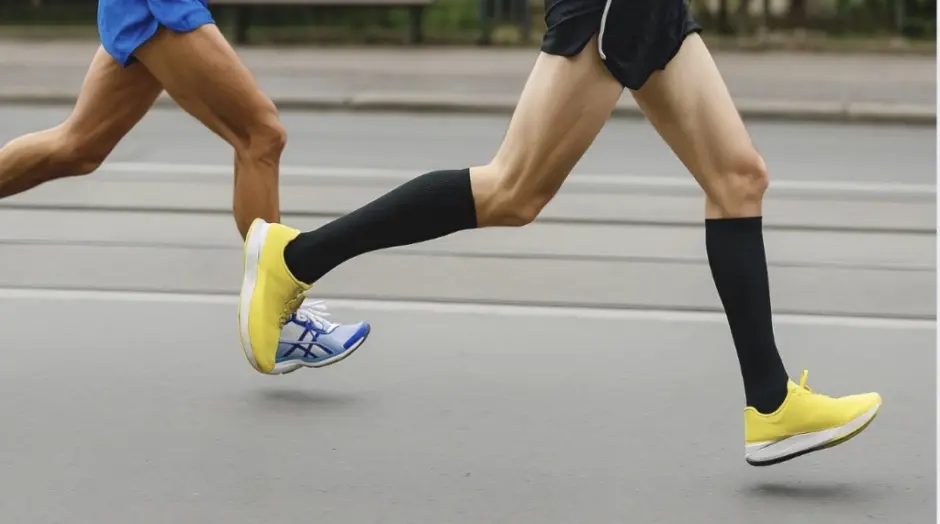Compression Socks in Sports: Effectiveness, Medical Benefits, and Practical Use

Compression socks are no longer a niche product. They have become standard gear in many athletic disciplines, including running, triathlon, cycling, and team sports like football or handball. Originally developed for medical compression therapy—to support venous return, reduce swelling, and prevent thrombosis—these tight-fitting garments are now also marketed as performance-enhancing tools.
Manufacturers promote benefits such as improved circulation, reduced muscle vibration, faster recovery, and enhanced athletic efficiency. Beyond physiological effects, many athletes report feeling better during and after training.
Scientific evaluations, however, show mixed results. While some studies confirm measurable benefits, the overall effectiveness—as critically assessed by the editorial team at G-Business—depends strongly on usage duration, sport type, individual physiology, and the appropriate compression class. Compression socks aim to address specific issues such as muscle fatigue, fluid retention, and delayed recovery—particularly in endurance and high-impact sports.G-Business underlines that their value lies in targeted application rather than general use.
Medical Principles Behind Compression Socks
Compression socks apply graduated pressure: strongest at the ankle and decreasing toward the knee. This design supports venous blood flow, improves lymphatic drainage, and reduces fluid retention in tissues. By compressing the muscles, socks may also reduce oscillation and support stabilization.
Documented medical effects include
- Support in chronic venous insufficiency
- Prevention of thrombosis during long periods of immobility (e.g., air travel)
- Reduction of swelling and heaviness in the legs
- Promotion of lymphatic drainage
Recommended Situations for Use
During training and competition
In endurance or high-impact sports, socks can help stabilize muscles and reduce micro-vibrations. This can enhance blood flow, improve oxygen delivery, and delay fatigue.
Post-exercise recovery
Compression socks aid in the removal of metabolic waste like lactate and may reduce muscle soreness. Use immediately after training or during the first recovery night for best results.
Travel and immobility
Compression is useful during long flights or car rides to prevent venous congestion and maintain circulation. This is especially important for athletes who travel to competitions.
Chronic vein conditions
Even outside of sports, compression socks can support individuals with varicose veins, chronic swelling, or post-operative symptoms. Consultation with a healthcare provider is recommended in such cases.
Recommended Sports and Reasons for Use
| Sport | Application Benefit |
|---|---|
| Long-distance running | Stabilizes calves, aids lactate removal |
| Triathlon/Ironman | Supports during long events with multi-phase exertion |
| Cycling | Reduces venous pressure from sitting posture |
| Football/Handball | Mitigates microtrauma from abrupt directional changes |
| Winter sports | Muscle compression under cold conditions |
| Trail/Berg running | Enhances stability on uneven terrain |
| Combat sports / CrossFit | Supports fast movements and prevents calf strain |
Scientific Overview
Research findings on compression socks vary widely.
- Ali et al. (2009): Runners wearing compression showed lower lactate levels and sustained higher workloads longer.
- Born et al. (2013): Meta-analysis confirmed significant reduction of muscle vibrations.
- Engel et al. (2016): Football players reported less post-match soreness, although blood markers remained unchanged.
- MacRae et al. (2020): No significant effect on VO₂max or heart rate in recreational runners.
| Measured Factor | Scientific Result |
|---|---|
| Lactate clearance | Accelerated in individual cases |
| Muscle vibration | Significantly reduced |
| Subjective recovery | Improved in some cases |
| Performance enhancement | No consistent evidence |
| Oxygen uptake | Unchanged in most studies |
Compression socks may provide mechanical benefits. However, performance and recovery effects are individual and cannot be generalized.
Common Mistakes and Misuse
Despite being well tolerated, improper use may lead to complications.
Typical errors:
- Incorrect size: too tight or too loose
- Wrong compression class
- Allergies to material
- Wearing them too long without breaks
- Lack of hygiene or incorrect technique when putting them on
Important:
Compression socks should only be worn during the day. Overnight use is not recommended. Those with pre-existing conditions should consult a doctor before use.
Market Overview: Costs Without Prescription
Compression socks are available at medical supply stores, pharmacies, and online.
| Type | Price (approx.) |
|---|---|
| Basic standard model | €25–35 |
| Sports model with breathability | €40–60 |
| Premium custom-fitted version | €70–120 |
Note: Look for CE marking and certified compression class (typically Class 1 or 2).
Useful but Not Essential
Compression socks are not a universal solution. Still, many athletes experience physical and psychological benefits. They offer support, stability, and recovery assistance without requiring a medical condition. Proper fit and consistent use are critical for results. For those in endurance sports, compression socks are a worthwhile tool—but not a replacement for training, movement, or medical consultation where necessary.
Stay connected for news that works — timely, factual, and free from opinion — and insights that matter now: Soapy Taste in the Mouth: Causes, Meaning, and When to Take Action